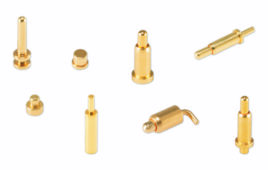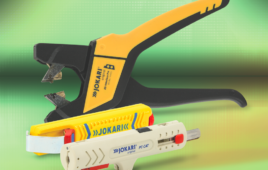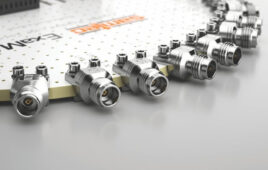Fluid power was well-represented at Agritechnica, the world’s largest agricultural-machinery trade fair held last month in Hannover, Germany. Fluid Power World recently noted that Linde Hydraulics received the Agritechnica Silver Innovation Medal for its HMV105D drive motor. Here are five more companies that earned Agritechnica prizes for new-product developments, centered on fluid power, that offer fundamental improvements for agricultural applications.

Peecon Gull Wing
Peecon Gull Wing (www.peecon.com)
Tractors with dual wheels often exceed the permitted overall width for travel on public roads. This new hydraulic folding system lets operators quickly deploy or stow rear dual wheels using the tractor hydraulics. During road travel, the dual wheels fold up and behind the cab. This limits tractor width to help ensure road safety. When the machine reaches the field, the operator folds down the wheels without having to leave the cab, saving time and effort. The duals attach to the rear wheels via a special coupling and the tractor is ready for work. The system attaches to the rear drivetrain of the tractor, so the lift system can to link other machines. The Gull Wing is suitable for many tractor brands and tire sizes.
Lemken hydraulic plow adjustment (https://lemken.com)

Lemken hydraulic plow adjustment
Lateral pull is unavoidable in conventional semi-mounted reversible plows because traction points of the tractor and plow are fixed. If the direction of draft is set incorrectly, torque develops around the tractor’s vertical axis near the middle of the rear axle. As a result the front axle tends to move sideways, and that increases rolling resistance and fuel consumption.
Lemken has introduced an adjustment system that improves lateral plow guidance by adding a hydraulic cylinder at the plow’s pivot point. The pressure-controlled cylinder transfers additional torque to the tractor to compensate for lateral pull. This shifts the tractor/plow traction line toward the center of the rear axle, reduces lateral pull and, in turn, improves fuel economy. Tests show the new OptiLine adjustment system provides fuel savings of up to 10%. Plowing without lateral pull also means considerably less work for operators, as they do not need to countersteer, as well as more-consistent furrow widths and depths.
ROPA hydraulic chassis control (www.ropa-maschinenbau.de)

ROPA R-Soil Protect hydraulic chassis control
ROPA’s R-Soil Protect hydraulic chassis control reduces soil compaction for more-efficient harvesting of root crops like beets. It’s reportedly the first triple-axle system that provides hydraulic load compensation. The automatic leveling system uses a network of six hydraulic cylinders and sensors (two per axle). It hydraulically supports the axles and equalizes loads on all wheels, which prevents peak load on any one wheel. Compared to previous three-axle beet harvesters with a central fixed axle, this design substantially reduces machine sway, compensates for uneven ground, provides roll stability and improves row and depth control. And on slopes, it shifts the load and center of gravity up-slope to keep the chassis horizontal at side slopes of up to 10%. This reduces loads and track depth on the lower wheels.
The system also adjusts pressure inside large flotation tires (Michelin CerexBib IF 1000/55 R32) and—similar to tracks—spreads the weight over a larger contact area and reduces wheel pressure on the contact area by 33%. In addition to minimizing soil compaction, it also increases traction and makes for more-efficient harvesting.
AGCO–Fendt VarioDrive (www.fendt.com)

Fendt tractor with VarioDrive
Growing engine power and an increasing demand for higher efficiency has spurred new powertrain developments. Conventional four-wheel drive tractors usually have a fixed torque ratio between front and rear axles. The Fendt VarioDrive powertrain, in contrast, constantly compares and adjusts the speeds of the front and rear axles. This eliminates excessive wheel slip and torsional losses in the powertrain. It enables variable four-wheel drive with torque distributed over two transmission outputs independently on both axles.
A “T-piece” mounted in the hydraulic circuit between the pump and hydraulic motors for the front and rear axles varies torque distribution in the 4WD. It acts as a hydrostatic differential between the axles and adjusts oil flow between the pump and hydraulic motor as needed. As a result, torque can automatically shift from one axle to the other via an intelligently controlled four-wheel clutch.
The new drive exploits high engine power and keeps speeds low, regardless of ground conditions. For example, with variable 4WD, the front-wheel drive can actively pull the tractor into the curve—the so-called “pull-in-turn” effect—which reduces the tractor’s turning circle by up to 10%. As ground speed increases, the system uncouples the hydraulic motor on the front axle to increase overall driveline efficiency and minimize wear on the front tires caused by cornering on firm substrates.

John Deere EZ Ballast
John Deere EZ Ballast (www.deere.com)
Adding ballast to a tractor balances forces by increasing weight on the front tires, which improves traction. However, mounting or removing rear wheel weights, or pumping water into the tires, to adapt a tractor’s weight to operating conditions is time consuming and, therefore, unpopular with farmers. Another drawback is that tractors are often over-ballasted, except for particularly heavy-duty applications. That hurts fuel economy. EZ Ballast is an underbelly design that hydraulically mounts the ballast. An operator can quickly add a 1.7-ton ballast weight to the bottom of the tractor chassis using controls in the cab. The time saving system evenly distributes weight on the axles and is a more-productive way of ballasting a tractor.
Filed Under: Hydraulic equipment + components, Couplings, CONNECTIVITY • fieldbuses • networks




